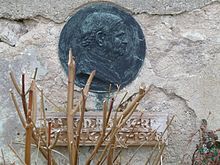Heinrich Bauser
Heinrich Bauser (born July 4, 1858 in Neustadt in the Black Forest , † December 18, 1942 in Karlsruhe ) was a German sculptor .
Life
Bauser was the son of the Sparkasse director and mayor Johann Bauser († 1899) and his wife Magdalena Hug. He entered the Munich Academy of Fine Arts on October 13, 1884 , where he studied sculpture. From 1886 to 1892 he continued his training with Hermann Volz at the academy in Karlsruhe . From 1894 to 1920 he worked as a clay modeling specialist at the TH Karlsruhe , before accepting a teaching position for modeling at the academy from 1920 to 1922, which had meanwhile become the Baden State Art School.
In 1899 he was a member of the Karlsruhe Art Cooperative and thus also of the General German Art Cooperative .
The Catholic Bauser married the Protestant Amalie Wilhelmine Vogel (born February 17, 1868 in Heidelberg) in Bonn on August 16, 1895. He married his second, also Protestant wife, Luise Margareta Rosa Henriette Mejer (born September 27, 1871) on May 23, 1903 in Mahlberg, Baden .
plant
In addition to the restoration of the palaces in Heidelberg , Bruchsal and Rastatt , Bauser was mainly entrusted with building sculptures in the Grand Duchy of Baden . His works in this genre were placed in front of the Kunstverlag (1900) and the municipal hospital (1903–1907) in Karlsruhe .
In 1896 he and his colleague Ludwig Kleiber created the stallion fountain in Durlach . This was designed by Hermann Götz in honor of Christian Hengst , who founded the forerunner of the later Durlach volunteer fire department. In 1907 Bauser provided a granite boulder with a relief plate by Otto von Bismarck, also in Durlach, on behalf of the Bismarck Society . The damaged plate at Bismarckplatz was removed in the 1950s and only replaced by a new version by Ulrich J. Sekinger in 2001 . In 1927 he created a bust of Friedrich Ries (1878–1917), the former head of the City Garden Directorate in Karlsruhe. The base of the monument in the city garden came from the architect Friedrich Beichel (1875–1955). In the city collections there is also a bronze statuette of Johann Peter Hebels from 1928. A plaster bust of the writer and railway engineer Albert Bürklin is in the collections of the Karlsruhe city archive, but is not on display. In front of the mausoleum for Bürklin's family in Karlsruhe's main cemetery are two sphinxes , which were also created by Bauser.
In Mannheim around 1900 he created stone reliefs and ornaments for the Hansahaus and from 1903 to 1905 the model of an oversized Badenia for the former district office (L6). Bauser made a war memorial for Boxberg in Baden and a memorial for Johann Jakob Astor in his hometown of Walldorf, inaugurated in 1898 .
In 1928 he designed a memorial for the victims of the First World War on the old Neustädter Friedhof on the Allmend opposite the cemetery chapel . The Neustadt historian Detlef Herbner also attributes the portrait medallions of his parents there, which adorn their listed graves there.
Exhibitions
- 1887: Ironwork in the orangery in Karlsruhe
- 1906: Art and applied arts in the Margravial Palace in Karlsruhe
- 1913: German art exhibition in Baden-Baden
reception
"The few surviving works are committed to the moderate naturalism of the Volz School."
Web links
Individual evidence
- ^ Karlsruhe registry office : death register . No. 3137/1942.
- ↑ a b Peter Stellmach: Titisee-Neustadt: The Disappeared Has Appeared , Badische Zeitung, January 29, 2011, accessed on February 5, 2012
- ↑ a b familysearch.org: Germany Marriages, 1558–1929, Heinrich Bauser , accessed on February 5, 2012
- ^ A b Matriculation AdBK Munich: Heinrich Bauser , accessed on February 5, 2012
- ↑ a b c d e f g h i j Beatrice Vierneisel: Heinrich Bauser in: Allgemeines Künstlerlexikon , De Gruyter, Berlin, New York 2005, ISBN 978-3-598-41800-6 (AKL VII, 1993, 639)
- ↑ wladimir-aichelburg.at: Members of the General German Art Cooperative in 1899 , access February 11, 2012
- ↑ registry office Bonn, marriage entry 219/1895
- ^ Durlach: Friends of the Pfinzgaumuseum - Historical Association Durlach eV: Fountain in Durlach | 064 Stallion Fountain , accessed June 23, 2011
- ↑ Information board at today's monument
- ^ Claudia Pohl: Art in urban space - sculpture guide for Karlsruhe. Tours to art in public space in Karlsruhe , Info, Karlsruhe 2005, ISBN 978-3-88190-399-8 , p. 362, excerpt in the Google book search
- ↑ Anett Beckmann: Mental history and aesthetic investigations of the sculptural tombs of the Karlsruhe main cemetery. Universität Karlsruhe , Universitätsbibliothek, Karlsruhe 2006, ISBN 3-86644-032-4 , S 62f, preview in the Google book search.
- ↑ mannheim.de: Badisches District Office , Access 18 February 2012
| personal data | |
|---|---|
| SURNAME | Bauser, Heinrich |
| BRIEF DESCRIPTION | German sculptor |
| DATE OF BIRTH | 4th July 1858 |
| PLACE OF BIRTH | Neustadt in the Black Forest |
| DATE OF DEATH | December 18, 1942 |
| Place of death | Karlsruhe |


